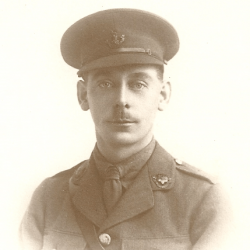Harold Edward Butterworth was born in Rochdale in October 1888. His father, James Butterworth, was a successful manufacturer of eyelets and eyelet hooks.
Harold was the youngest son of James Butterworth and Ann Lees Mayall. Harold also had four half brothers and sisters from his father’s first marriage to Martha Schofield.
By 1911 Harold was living with his mother and father at Laurel House, 149 Manchester Road, Rochdale and working in the family business as a traveling salesman. Also living with them was his sister Mary Lees Butterworth and his half brother William Mayall Butterworth along with two servants.
He was commissioned into the 1/9th Battalion Manchester Regiment on September 2, 1914 (supernumary) along with several others. He joined the Battalion while they were at Chesham Fold Camp, Bury and sailed with them to Egypt in September 1914 serving with them there throughout their training and preparation for action. He landed with the 1/9th in Gallipoli on May 9, 1915 as a platoon commander in B Company.
2nd Lieutenant H.E. Butterworth was reported wounded on May 16th in the Divisional war diary and listed on the May 28, 1915 London Times Casualty List; the first Officer of the 1/9th Manchesters to make the list. According to a letter written by 2/Lt. A.H. Hudson, and published in the North Cheshire Herald, June 26th 1915, 2/Lt. Butterworth was shot in the leg while sitting with some other Officers playing cards. Evidently he was not seriously wounded as regimental records show him rejoining the Battalion 4 days later.
The London Gazette notes that he was later appointed temporary Lieutenant with precedence from June 7, 1915. Regimental records indicate that he was evacuated sick to No 21 General Hospital hospital at Ras-el-Tin Barracks, Alexandria on June 9, 1915, on the hospital ship Grantully Castle. He remained there for 10 days until he was discharged to an Officer’s Convalescent Home at Ramleh. He remained absent from the battalion for 68 days rejoining them in Gallipoli on August 16th. He is not referenced in the Battalion or Brigade war diaries in Gallipoli except to note that on September 6th he led a group of 50 Other Ranks as Guard to GHQ on Imbros and was subsequently evacuated sick to St. Andrews Hospital in Malta on September 22, 1915, arriving there on October 1. Here he was treated for dysentery and on October 29 was well enough to embark the hospital ship Italia at Valetta for England, arriving at Southampton on November 10. Here he was medically assessed and granted leave until December 24, 1915. Ironically, in a letter published on October 9th in the Ashton Reporter, he is mentioned as being only one of four Officers who joined the Battalion in Bury who was still present at Gallipoli.
He was promoted to Lieutenant on June 1, 1916 and the Battalion war diary next mentions him as arriving in Egypt from the UK on June 4, 1916. On September 2, 1916 he attended a school of instruction for 3 weeks and the following month was allowed 4 days leave in Cairo from November 26-30, along with 2/Lieut. Marsden. On January 31, 1917 he left the Battalion and formed part of the Advance Party in Port Said, (along with Major Nowell, 2/Lt. Greenwood and 2/Lt. Needham), preparing for the Battalion’s imminent departure to France.
He rejoined the 1/9th in France, on March 17, 1917, and is noted as being a platoon commander on April 22, 1917 when the Battalion was in Epehy. On June 3 he returned from 2 weeks leave in the UK and attended a week’s course of unspecified instruction in late June. In early August 1917 he attended a week’s bombing course at Divisional HQ. He was promoted to Captain on August 5, 1917. He is noted as commanding C Company on October 13 and later that month, on October 25, he proceeded to England on leave, rejoining the Battalion 17 days later on November 11th.
On March 21, 1918 the 9th Manchesters were serving in the in the 198th Brigade of the 66th (2nd/East Lancashire) Division. The 9th Battalion were in the support line south of Péronne between Ferme Lamire and Eterpigny on the morning of March 23, 1918. But on the morning of March 22nd, 2 Companies of the 9th Battalion were in front of Trinket redoubt and it’s probable that the Battalion retired through Roisel during the evening of the 22nd or the early hours of the 23rd. Capt. Butterworth was reported missing and was subsequently found to have been taken prisoner of war.
After the war, orders to reform the regiment were received in October 1920 and Lt-Col D. H. Wade was appointed Commanding Officer. A few weeks later the War Office confirmed the re-appointments of some old officers including Captain Butterworth.
On September 10, 1924 he married Margaret Bessie Hitchon, in Rochdale, and on March 11, 1926 they had twin boys; Richard Mayall Butterworth and James H. Butterworth. He lived in Healey, Rochdale and worked in the family business, until it closed down, and thereafter as a company director. He was very active in the local community serving as vice president of Rochdale Rugby Union Club, vice president of the Healey Conservative Club and president of the Shawclough and Healey Band.
He remained in the Territorials and on December 28, 1926 was promoted to Major with precedence from January 28, 1926. He resigned his commission three years later, on January 30, 1929.
Major Harold Edward Butterworth died in Rochdale on May 4, 1939. He was 50 years old. He was buried in the family grave at Rochdale Cemetery, on Monday May 8, 1939 with full military honours, a detachment of the 9th Battalion Manchester Regiment acting as bearers. Also present at the funeral were Colonel William Marsden Barratt, Colonel George William Handforth and Captain Henry Chorlton Shaw of the 9th Battalion.

